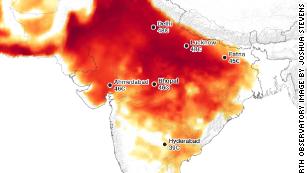What happens when parts of South Asia become unlivable? The climate crisis is already displacing millions
Analysis by James Griffiths, CNN
Updated 2:15 AM ET, Wed July 17, 2019
cnn.com
excerpt:
(CNN)Almost six million people are under threat from rising flood waters across South Asia, where hundreds of thousands of people have already been displaced as a result of heavy monsoon rains.
The flooding comes as India was still reeling from a weeks-long water crisis amid heavy droughts and heatwaves across the country which killed at least 137 people. Experts said the country has five years to address severe water shortages, caused by steadily depleting groundwater supplies, or over 100 million people will left be without ready access to water.
In Afghanistan, drought has devastated traditional farming areas, forcing millions of people to move or face starvation, while in Bangladesh, heavy monsoon flooding has marooned entire communities and cut-off vital roads. Especially at risk are the hundreds of thousands of Rohingya refugees living in fragile, makeshift camps along the country's border with Myanmar.
This is the sharp edge of the climate crisis. What seems an urgent but still future problem for many developed countries is already killing people in parts of Asia, and a new refugee crisis, far worse than that which has hit Europe in recent years, is brewing.
Monsoon disaster
Agriculture in South Asia has depended on the annual monsoon for centuries. If the rains arrive late, as they did this year, they can cause widespread drought and water shortages. Since the late 19th century, scientists and government agencies have sought to model and predict when the monsoon will come, a vital task in apportioning relief and assistance to the two billion or so people who depend on the monsoon for sustenance.
Climate change is making this task increasingly difficult, however. According to a study in the journal Nature, the warming of the Indian Ocean, the increasing frequency of the El Niño weather phenomenon, air pollution and changing land use across the subcontinent has led to steadily decreasing rainfall, increasing the variability of the monsoon and making it harder to accurately model.

Are parts of India becoming too hot for humans?
Cruelly, as the overall amount of rain has decreased, leading to drought, the frequency of extreme rainfall, causing flooding and landslides, has actually gone up, the Nature study found.
Researchers said there had been a threefold increase in "widespread extreme rain events" over central India between 1950 and 2015, which brought with them a potentially "catastrophic impact on life, agriculture and property."
"The overall intensity and frequency of extreme events are increasing over the region," the study said, adding that projected changes showed "further intensification of extreme precipitation over most parts of the subcontinent by the end of the century."
continues at cnn.com |





